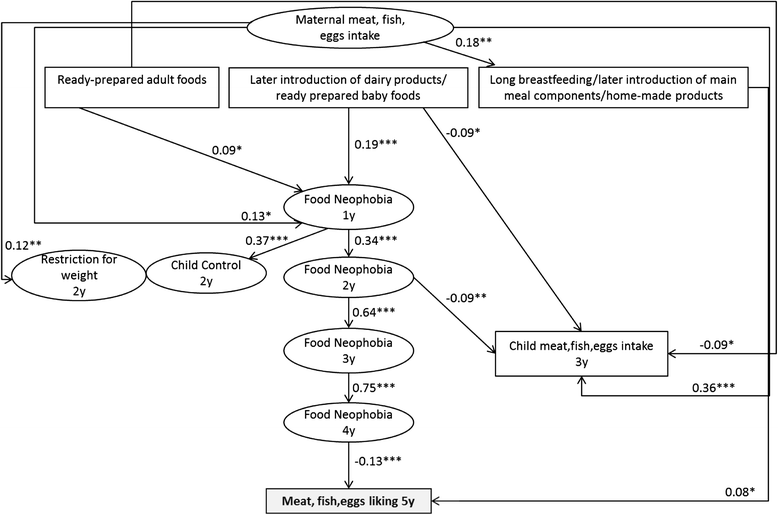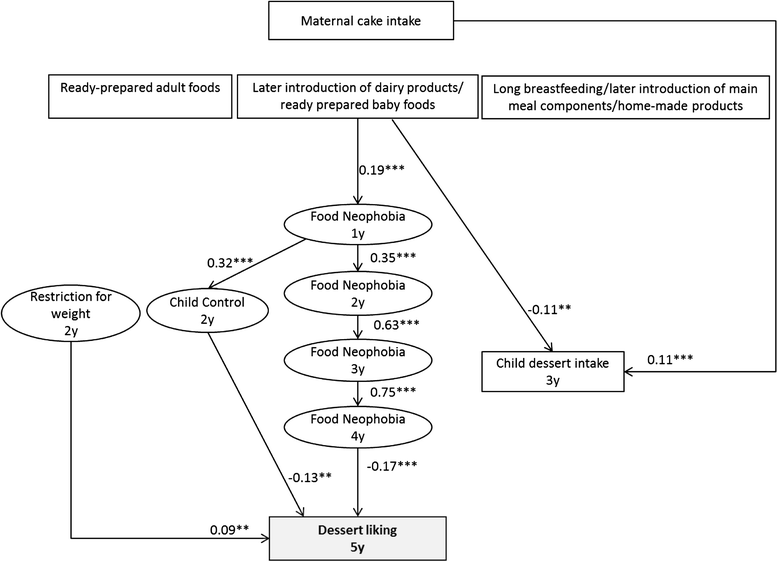Early determinants of food liking among 5y-old children: a longitudinal study from the EDEN mother-child cohort
- PMID: 26876058
- PMCID: PMC4753648
- DOI: 10.1186/s12966-016-0342-5
Early determinants of food liking among 5y-old children: a longitudinal study from the EDEN mother-child cohort
Abstract
Background: Identifying the determinants of child's liking for different foods may help to prevent future choices of unhealthy food.
Objective: To study early-life food-related characteristics associated with child's liking for different foods at 5y with a longitudinal study.
Design: 1142 5y- old children completed a liking test for "fruit and vegetables", "meat, fish and eggs", desserts and cheese. Data related to maternal food intake before pregnancy, infant feeding during the first year of life, maternal feeding practices at 2y, child's food intake at 3y, and child's food neophobia from 1 to 4y were collected prospectively from the mother. The associations between these factors and child's liking for each category of foods were analyzed using structural equation modelling.
Results: High food neophobia at 4 y was related to lower child's liking for all food groups. Maternal feeding practices at 2y were associated with liking for dessert: negatively for the practices allowing child to control his/her own food intake, positively for restriction of child's food intake for weight reasons. Moreover, child's food intake at 3y was positively associated with child's liking for "fruit and vegetables" as well as for cheese. Finally, adherence to the infant feeding pattern "long breastfeeding, later introduction of main meal components and use of home-made products" was positively associated with child's liking for meat/fish/eggs.
Conclusions: For all food groups, food neophobia was a common determinant of child's liking for food at 5y, whereas other factors were associated with food liking for specific food groups.
Figures




References
-
- Brug J, Tak NI, te Velde SJ, Bere E, de Bourdeaudhuij I. Taste preferences, liking and other factors related to fruit and vegetable intakes among schoolchildren: results from observational studies. Br J Nutr. 2008;99(Suppl 1):S7–14. - PubMed
-
- Birch LL. Preschool children's food preferences and consumption patterns. J Nutr Educ. 1979;11(4):189–92. doi: 10.1016/S0022-3182(79)80025-4. - DOI
-
- Sullivan SA, Birch LL. Pass the sugar, pass the salt: Experience dictates preference. Dev Psychol. 1990;26(4):546–51. doi: 10.1037/0012-1649.26.4.546. - DOI
Publication types
MeSH terms
LinkOut - more resources
Full Text Sources
Other Literature Sources

